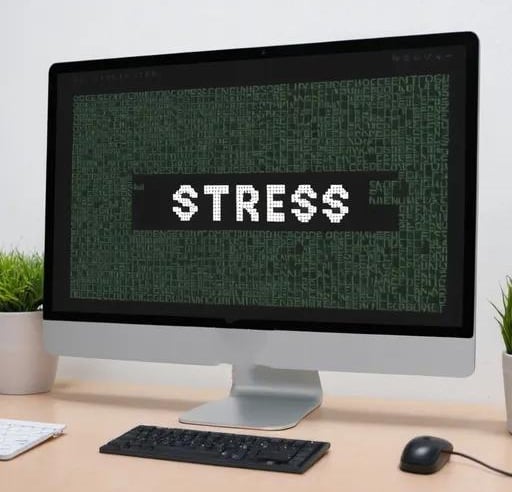Stress in the Digital Age: Managing Technology-Related Stress
Today we are more than ever exposed to the digital content of all sort. This article will equip you with some tools enabling you to properly disconnect and moderate the nagative influence that arises from the constant consuming of digital media.
7/17/20248 min read
In today's fast-paced world, technology is an integral part of our daily lives.
From smartphones and laptops to social media and email, we are constantly connected.
While these advancements have brought numerous benefits, they have also introduced a new form of stress: technology-related stress.
This article delves into the impact of digital stress and offers practical strategies for managing it effectively.


Understanding Technology-Related Stress
What is Technology-Related Stress?
Technology-related stress refers to the strain and anxiety experienced due to the constant use and reliance on digital devices. In our tech-driven society, this form of stress is becoming increasingly prevalent.
The endless flow of information can be overwhelming, leaving individuals feeling inundated.
People often feel pressured to stay connected and responsive at all times, fearing they might miss out on important updates or opportunities.
Social media significantly amplifies this stress by fostering a culture of constant comparison, where individuals measure their worth against curated online personas.
Additionally, cyberbullying and negative online interactions contribute heavily to technology-related stress, causing emotional distress and impacting mental health.
Types of Technology-Related Stress
Information Overload
Information overload occurs when the sheer volume of available information becomes unmanageable.
With a constant influx of news, updates, and notifications, individuals can find it difficult to process and prioritize information.
This can lead to feelings of being overwhelmed and unable to focus, affecting daily productivity and mental clarity.
Constant Connectivity
Constant connectivity creates an expectation of immediate responses.
The pressure to be always available, whether through emails, messages, or social media, can lead to significant stress.
This expectation can interrupt personal time, leading to difficulties in maintaining a healthy work-life balance and increasing stress levels.
Social Comparison
Social comparison on social media platforms can lead to feelings of inadequacy.
Seeing others' seemingly perfect lives can make individuals feel less accomplished or happy by comparison.
This continuous comparison can erode self-esteem and contribute to anxiety and depression.
Digital Fatigue
Digital fatigue results from prolonged screen time, causing both physical and mental exhaustion.
Symptoms can include eye strain, headaches, and a sense of mental burnout.
This fatigue can diminish overall productivity and well-being, making it challenging to engage with both digital and offline activities effectively.
The Impact of Digital Stress on Mental Health
How Digital Stress Affects Mental Health
Research shows that prolonged exposure to digital stress can significantly increase anxiety.
Constant notifications and the pressure to respond promptly can heighten anxiety levels, making it difficult to relax or focus on other tasks.
Negative interactions and social comparison on social media platforms can contribute to feelings of depression.
The curated nature of social media often presents an unrealistic standard of success and happiness, leading individuals to feel inadequate or unsuccessful by comparison.
The blue light emitted by screens can interfere with sleep patterns, leading to insomnia and poor sleep quality.
This disruption in sleep can have cascading effects on overall health, including increased stress and reduced cognitive function.
Additionally, multitasking and frequent interruptions caused by digital devices can reduce focus and productivity.
The mental strain of constantly switching between tasks can lead to cognitive overload and decreased efficiency.
Long-Term Effects of Digital Stress
Persistent Anxiety
Chronic exposure to digital stress can lead to persistent anxiety.
Over time, the constant state of alertness and the pressure to remain connected can develop into generalized anxiety disorder, a condition characterized by excessive, uncontrollable worry about various aspects of life.


Severe Depression
Ongoing exposure to the negative aspects of digital interaction can exacerbate depression.
Continuous negative comparisons, cyberbullying, and the absence of real-life social interactions can deepen feelings of hopelessness and worthlessness, making depression more severe and harder to treat.
Poor Sleep Quality
Poor sleep quality resulting from prolonged screen exposure can affect overall health and cognitive function.
Sleep is crucial for mental and physical restoration, and its disruption can lead to chronic fatigue, mood disturbances, and a decline in cognitive abilities.
Reduced Productivity
Reduced productivity can impact both professional and personal life.
The constant distractions from notifications and the mental load of managing digital information can hinder performance and efficiency, affecting career progression and personal achievements
Strained Relationships
Relationships may suffer due to increased irritability and lack of real-life interaction.
Digital stress can make individuals more irritable and less patient, straining relationships with family, friends, and colleagues.
The preference for digital communication over face-to-face interactions can also lead to feelings of loneliness and isolation.
Cognitive and Physical Health Implications
Digital stress can also have broader cognitive and physical health implications.
The strain on the eyes from prolonged screen use can lead to digital eye strain, characterized by dry eyes, blurred vision, and headaches.
Mentally, the constant engagement with digital devices can lead to a form of cognitive fatigue, where the brain becomes less efficient at processing information and making decisions.
Social and Emotional Well-Being
Social and emotional well-being are also deeply impacted by digital stress.
The reduction in face-to-face interactions can lead to weaker social bonds and a lack of emotional support.
Emotional well-being is compromised as individuals experience a range of negative emotions from online interactions, including anxiety, jealousy, and frustration.
Coping Mechanisms
Coping mechanisms for digital stress include mindfulness practices, regular breaks from technology, and seeking social support.
Mindfulness and meditation can help individuals become more aware of their stress levels and manage their reactions.
Regular breaks from technology, or digital detoxes, can provide necessary relief and help reset the mind.
Seeking social support from friends, family, or mental health professionals can offer a crucial outlet for discussing and managing stress.
Understanding the complex nature of technology-related stress and its wide-ranging impacts on mental health is essential for developing effective coping strategies.
By recognizing the signs and sources of digital stress, individuals can take proactive steps to mitigate its effects and enhance their overall well-being.


Strategies for Managing Technology-Related Stress
Set Boundaries
Establish clear boundaries for technology use to reduce stress.
Designate specific times for checking emails and social media.
Stick to these limits to avoid constant connectivity. Use features on your devices that limit screen time.
Block notifications during certain hours to create uninterrupted periods. Setting boundaries helps regain control over digital interactions.
Regularly disconnect from your digital devices to recharge.
Schedule tech-free times or days to reconnect with the offline world.
Engage in activities like reading a book or going for a walk.
Spend quality time with loved ones without digital distractions.
A digital detox provides a much-needed break from the constant stream of information.
This practice can significantly reduce digital fatigue.
Practice Digital Detox
Optimize Your Digital Environment
Adjust your device settings to reduce digital strain. Use blue light filters to minimize the impact on your sleep.
Increase font sizes to make reading easier and reduce eye strain.
Customize notifications to minimize disruptions during focused work periods.
Creating a more user-friendly digital environment can alleviate stress.
These small adjustments can make a big difference in how you interact with technology.
Prioritize Real-Life Interactions
Make a conscious effort to prioritize face-to-face interactions over digital communication.
Building strong, in-person relationships provides emotional support.
Real-life interactions can reduce feelings of isolation and loneliness.
Engage in social activities that do not involve screens.
Strengthen bonds with friends and family through shared experiences.
Prioritizing real-life connections helps balance digital interactions.
Practice Mindfulness and Stress-Reduction Techniques
Incorporate mindfulness practices such as meditation into your daily routine.
Deep breathing exercises can help manage stress effectively.
Yoga is another excellent technique for reducing stress and improving overall well-being.
These practices help you stay grounded and present.
Mindfulness can counteract the mental strain caused by digital stress.
Numerous apps offer guided mindfulness sessions designed to address these issues.
Seek Professional Help
If technology-related stress significantly impacts your mental health, consider seeking professional help.
Therapists and counselors can provide strategies and support to manage stress.
Professional guidance can help you develop healthy digital habits.
Therapy can address underlying issues contributing to digital stress.
Do not hesitate to seek help if you feel overwhelmed.
Professional support is a valuable resource in managing digital stress.
Embracing a Balanced Approach to Technology
Finding Balance in the Digital Age
While technology is here to stay, adopting a balanced approach can help mitigate its negative effects.
Set boundaries to manage your digital interactions.
Practice mindfulness to stay present and reduce stress.
Prioritize real-life interactions to build strong relationships.
Engage in regular digital detoxes to recharge.
Optimize your digital environment for a more user-friendly experience.
Finding balance allows you to enjoy technology without succumbing to its stressors.
Creating a Healthy Digital Lifestyle
A healthy digital lifestyle involves mindful use of technology.
Be intentional about when and how you use digital devices.
Create routines that include tech-free times and activities.
Stay aware of the impact digital interactions have on your mental health.
Make adjustments as needed to maintain a balanced approach.
A healthy digital lifestyle enhances overall well-being.
It is about using technology in ways that support, rather than detract from, your life
Conclusion
In the digital age, managing technology-related stress is crucial for maintaining mental health and overall well-being.
The pervasive presence of technology in our lives, while beneficial in many ways, has introduced unique challenges that we must address to lead healthier lives.
Understanding the sources and impacts of digital stress is the first step toward effective management. Recognizing how constant connectivity, information overload, social comparison, and cyberbullying contribute to our stress levels can empower us to take action.
Implementing practical strategies to manage digital stress is essential.
These strategies include setting boundaries for technology use, practicing digital detoxes, optimizing our digital environments, and prioritizing real-life interactions.
By establishing clear limits on when and how we use our devices, we can prevent the constant intrusion of notifications and reduce feelings of being overwhelmed.
Regular breaks from technology, or digital detoxes, allow us to reconnect with the physical world and recharge our mental batteries.
Customizing our device settings to reduce strain and interruptions can create a more user-friendly and less stressful digital experience.
Creating a healthier, more balanced relationship with technology is possible and necessary for our mental health. It is not about eliminating technology from our lives but about finding a harmonious balance.
This balance allows us to enjoy the benefits of technology while minimizing its adverse effects.
Achieving this harmony requires conscious effort and mindfulness.
We need to be aware of how much time we spend on our devices and the quality of our digital interactions.
By being intentional about our technology use, we can ensure it enhances rather than detracts from our lives.
Thriving both online and offline is achievable with conscious effort and deliberate action.
Engaging in activities that do not involve screens, such as outdoor exercise, reading, or face-to-face socializing, can enrich our lives and provide a respite from digital stress.
Mindfulness practices like meditation, yoga, and deep breathing exercises can help us manage stress and remain present.
These techniques can counterbalance the mental strain caused by constant digital engagement.
By following these strategies, you can take control of your digital experience and significantly reduce the stress associated with constant connectivity.
It is within your reach to implement these practices and improve your mental health.
Doing so will not only enhance your overall quality of life but also ensure that your relationship with technology is beneficial and sustainable.
The ultimate goal is to lead a balanced life where technology serves as a tool that supports our goals and well-being rather than a source of constant stress.
Enhancing your overall quality of life is the ultimate goal, and it is entirely attainable with the right approach.
Taking the necessary steps to manage technology-related stress effectively is a commitment to your mental well-being.
This commitment involves ongoing self-assessment and adjustment of your digital habits to ensure they align with your health and happiness.
Your mental well-being is worth the effort, and by prioritizing it, you can navigate the digital age with resilience and peace of mind.
